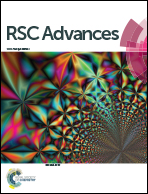A mechanism of surface hardness enhancement for H+ irradiated polycarbonate
Abstract
H+ irradiation increases the surface hardness of polycarbonate. Nano indentation measurement shows that the hardness increases up to 3.7 GPa at the dose of 5 × 1016 # cm−2 and at the irradiation energy of 150 keV. In addition, the hardness increases with the dose and the energy of H+ irradiation. In accordance with the nano indentation measurement, the Fourier-transform infrared spectroscopy (FTIR) depends on the dose and energy of H+ irradiation. The peak at ∼1500 cm−1 for the aromatic ring and the peak at ∼1770 cm−1 for the C![[double bond, length as m-dash]](https://www.rsc.org/images/entities/char_e001.gif) O stretch decrease with increasing dose and energy, while the increase of the dose and energy develops a new C
O stretch decrease with increasing dose and energy, while the increase of the dose and energy develops a new C![[double bond, length as m-dash]](https://www.rsc.org/images/entities/char_e001.gif) O stretch vibration at ∼1700 cm−1 and forms aromatic hydrocarbons at ∼1600 cm−1. X-ray diffraction experiments are also consistent with the nano indentation measurement and FTIR spectra. Based on the experiments, we discuss a possible mechanism of the surface hardness enhancements by ion beam irradiation.
O stretch vibration at ∼1700 cm−1 and forms aromatic hydrocarbons at ∼1600 cm−1. X-ray diffraction experiments are also consistent with the nano indentation measurement and FTIR spectra. Based on the experiments, we discuss a possible mechanism of the surface hardness enhancements by ion beam irradiation.



 Please wait while we load your content...
Please wait while we load your content...